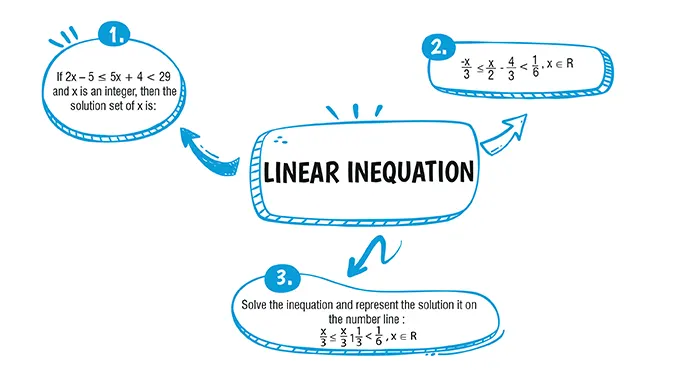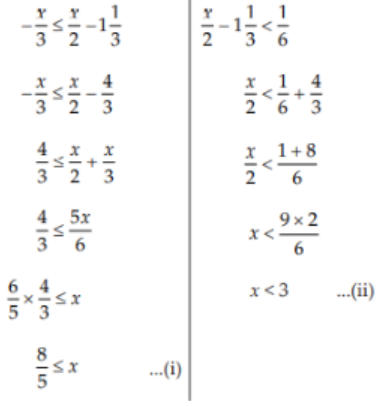Table of Contents

Ans. (d) {– 3, – 2, – 1, 0, 1, 2, 3, 4}
Explanation:
We have
2x-5 ≤ 5x+4 < 29, x ∈ I \\
⇒ 2x-5 ≤ 5x+4; 5x + 4 < 29 \\
⇒ 2x - 5x ≤ 4 + 5; 5x < 29 - 4 \\
⇒ - 3x ≤ 9; 5x < 25 \\
⇒\frac{-3x}{-3} ≥ \frac{9}{-3}; \frac{5x}{5} < \frac{25}{5} \\
⇒ x ≥ - 3; x < 5
∴ x = {– 3, – 2, – 1, 0, 1, 2, 3, 4}

Ans. (b) {x : x ∈ R, –2 < x ≤ 3}
Explanation:
{x : x ∈ R, –2 < x ≤ 3} The adjacent figure shows x > - 2 and x ≤ 3
So, answer will be
{x : x ∈ R, -2 < x ≤ 3}
Explanation:
we have,
\frac{x}{3} ≤ \frac{x}{3} 1 \frac{1}{3} < \frac{1}{6} , x ∈ R

Now,
Thus, \frac{8}{5} ≤ x < 3 \space Or \space 1.6 ≤ x < 3 \\
∴ \text{Solution set =} [ x : 1.6 ≤ x < 3, ∈ R ].
Explanation:
Taking L.C.M. of 5, 2 = 10 and on multiplying throughout by 10, we get:
\frac{3x+15}{5} × 10 ≤ (2x + 3) × 10 ≤ \frac{3x+15}{2} \\
× 10 2(3x+15) ≤ 10(2x+3) ≤ 5(3x+15), \\
which on simplification gives:
6x + 30 ≤ 20x + 30 ≤ 15x + 75,
Solving the LHS part:
6x + 30 ≤ 20x + 30
⇒ 14x ≥ 0
⇒ x ≥ 0...........(i)
Again, solving the RHS part: 10(2x+3) ≤ 5(3x+15)
⇒ 20x + 30 ≤ 15x + 75
⇒ 20x - 15x ≤ 75 - 30
⇒ 5x ≤ 45
⇒ x ≤ \frac{45}{5} ⇒ x ≤ 9 ...........(ii)
Download Mind Map of this chapter
Download NowWant to Practice Mock Tests of this chapter
Practice NowDownload Important Questions of this chapter
Download Now| Chapter No. | Chapter Name |
|---|---|
| Chapter 1 | Goods and Service Tax (GST) |
| Chapter 2 | Banking |
| Chapter 3 | Shares and Dividends |
| Chapter 4 | Linear inequations |
| Chapter 5 | Quadratic Equations in one variable |
| Chapter 6 | Ratio and proportion |
| Chapter 7 | Factorization |
| Chapter 8 | Matrices |
| Chapter 9 | Arithmetic Progression |
| Chapter 10 | Geometric Progression |
| Chapter 11 | Coordinate Geometry |
| Chapter 12 | Reflection |
| Chapter 13 | Similarity |
| Chapter 14 | Loci |
| Chapter 15 | Circles |
| Chapter 16 | Constructions |
| Chapter 17 | Mensuration |
| Chapter 18 | Trigonometry |
| Chapter 19 | Statistics |
| Chapter 20 | Probability |
| Chapter Wise Important Questions for ICSE Board Class 10 Mathematics |
|---|
| Goods and Service Tax (GST) |
| Banking |
| Shares and Dividends |
| Linear inequations |
| Quadratic Equations in one variable |
| Ratio and proportion |
| Factorization |
| Matrices |
| Arithmetic Progression |
| Geometric Progression |
| Coordinate Geometry |
| Reflection |
| Similarity |
| Loci |
| Circles |
| Constructions |
| Mensuration |
| Trigonometry |
| Statistics |
| Probability |
CBSE Important Questions Class 10
ICSE Important Questions Class 10
CBSE Important Questions Class 10
ICSE Important Questions Class 10